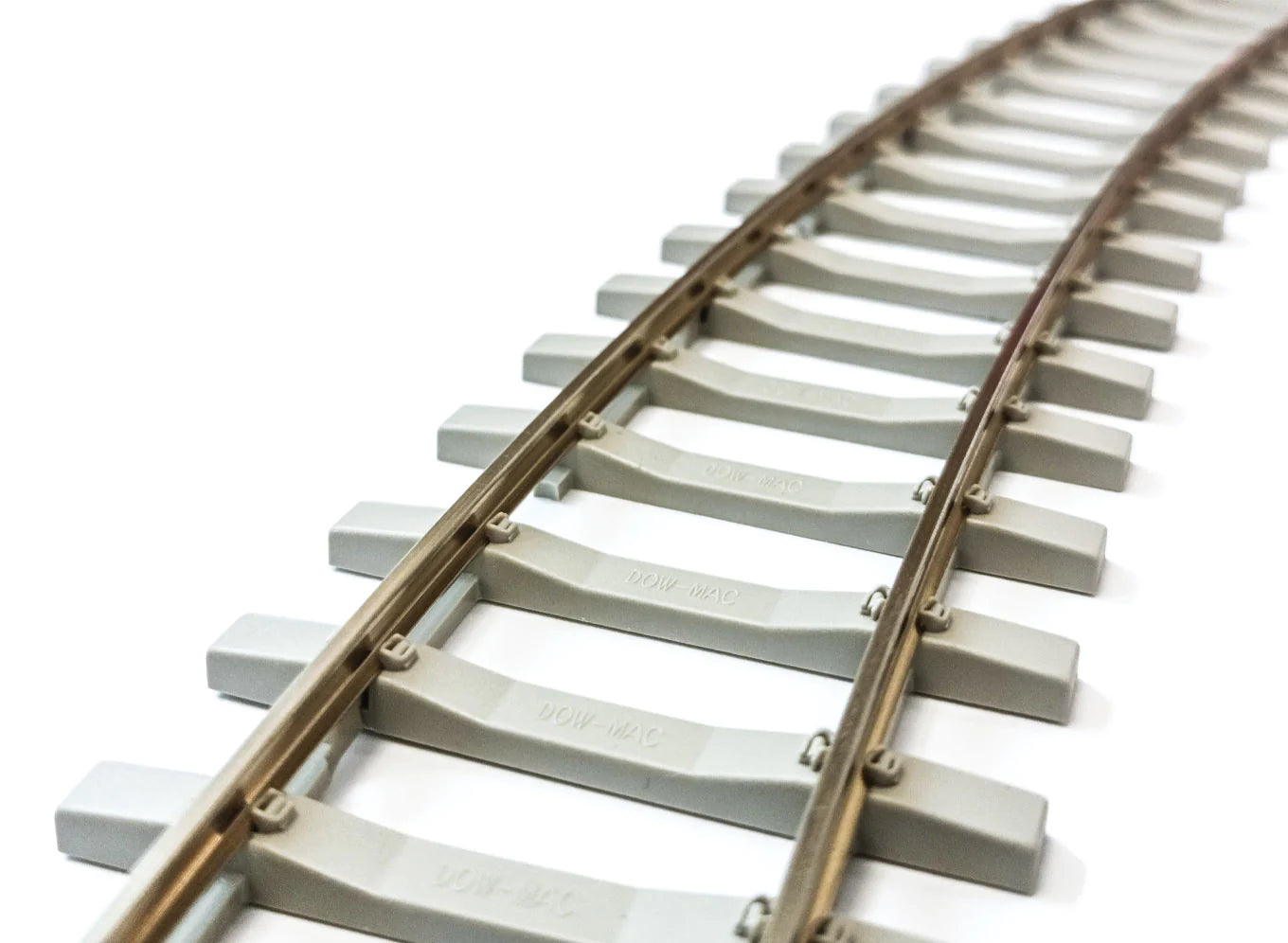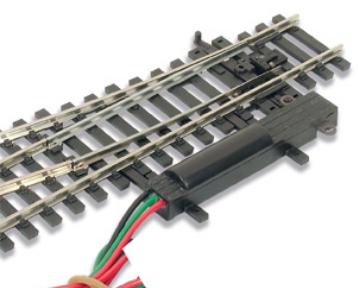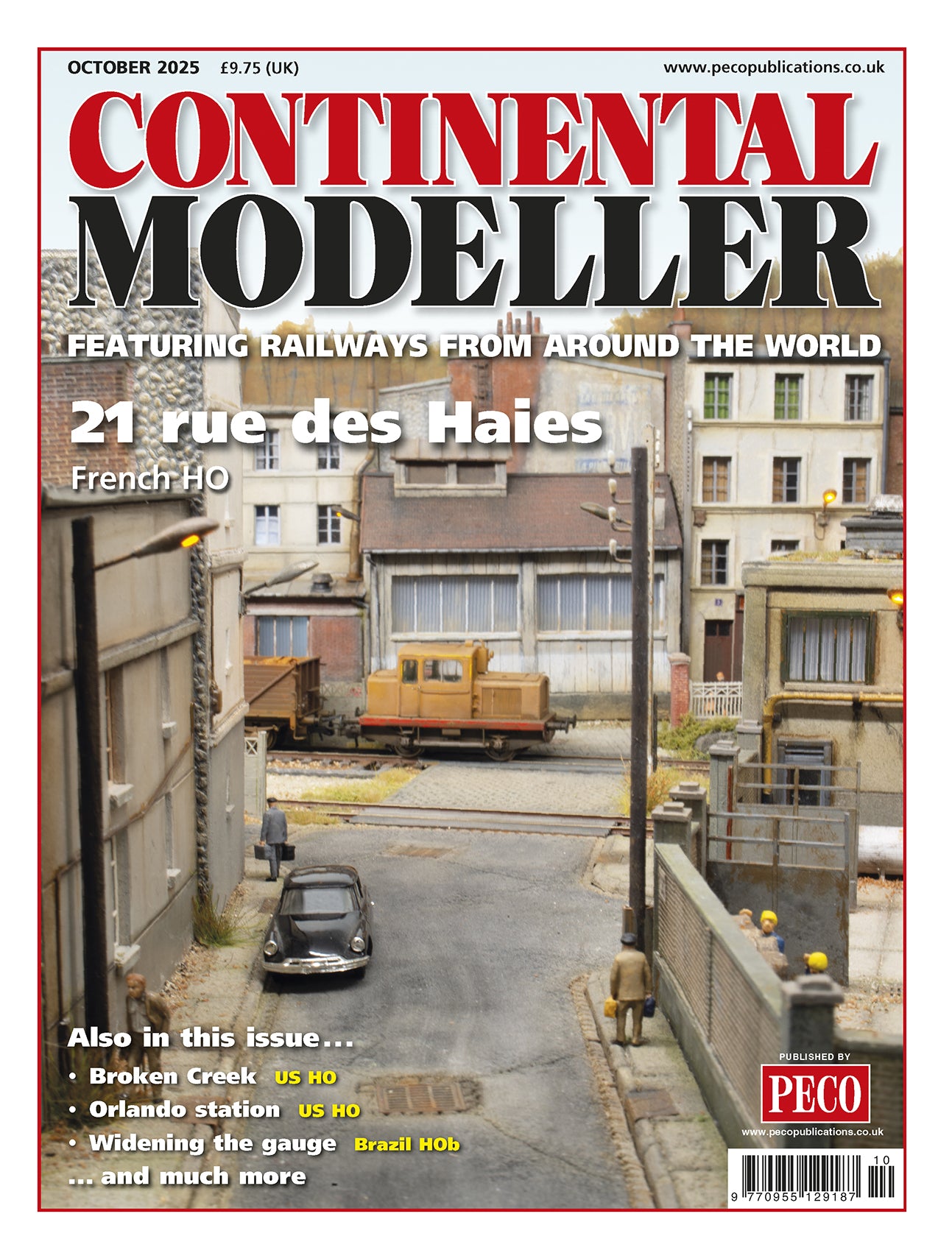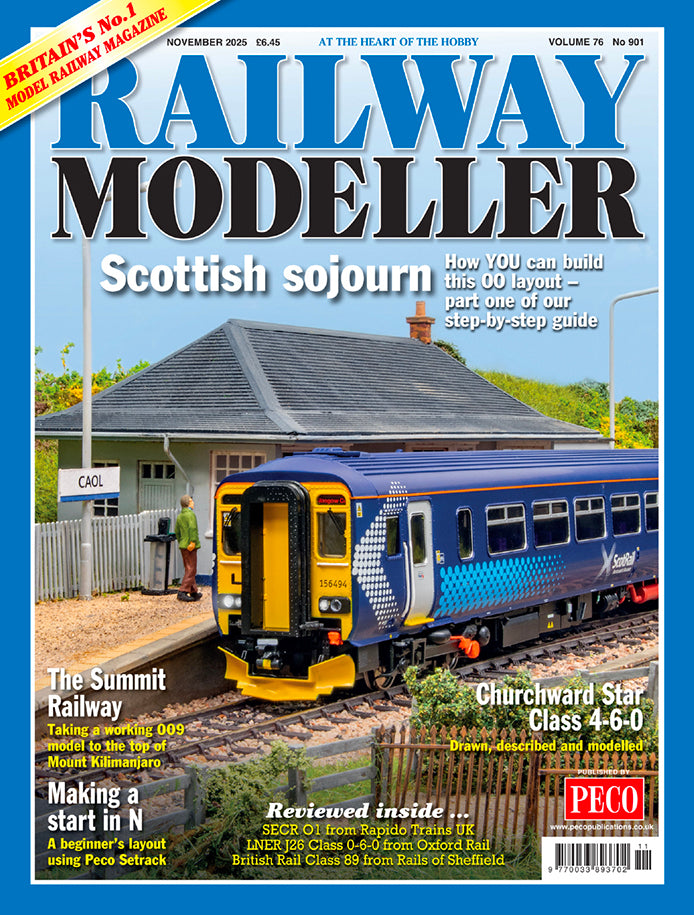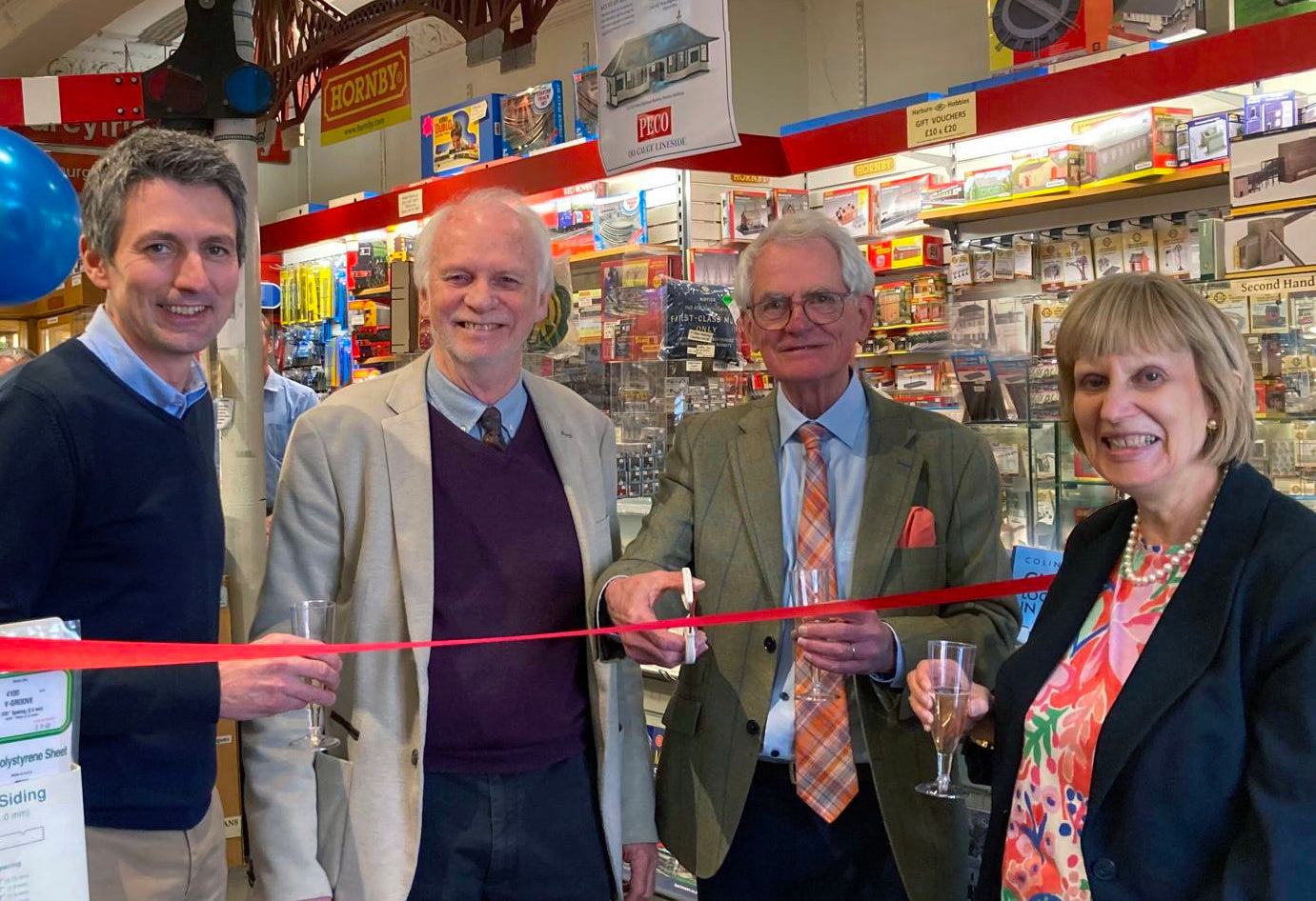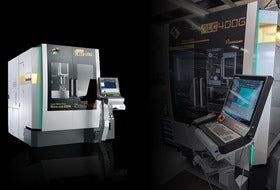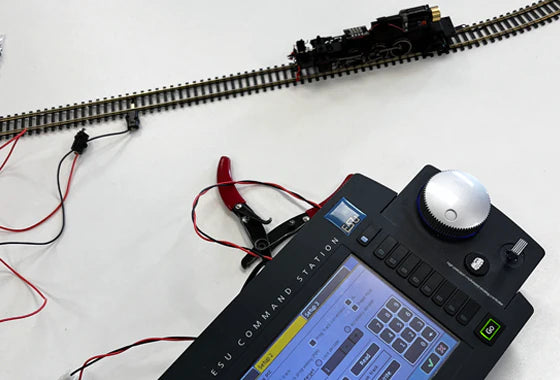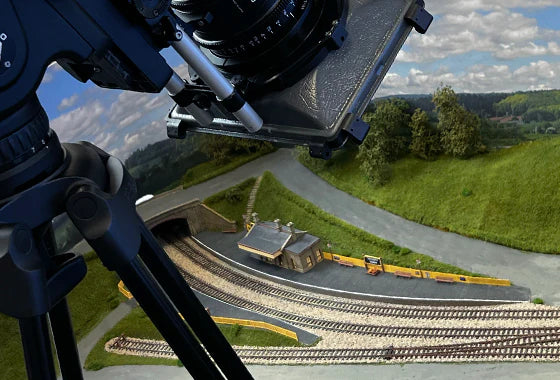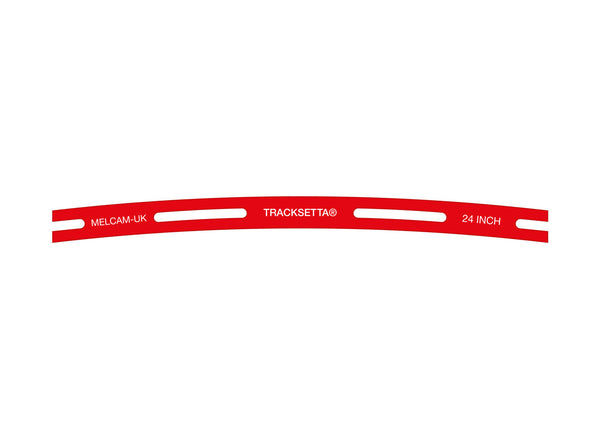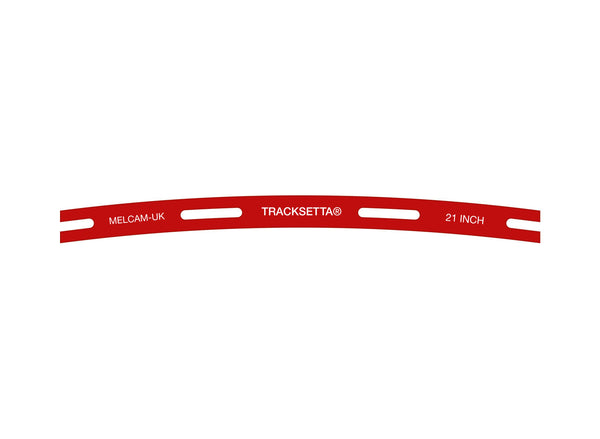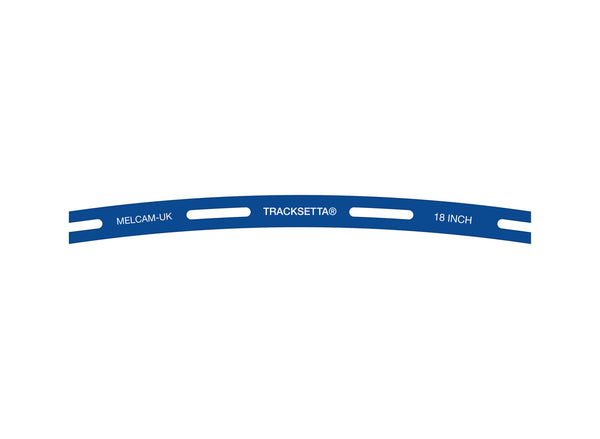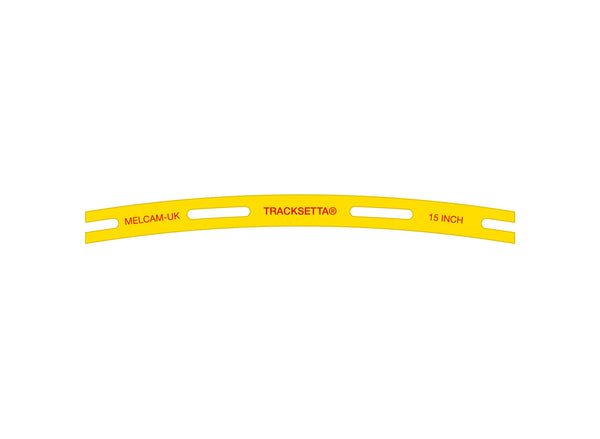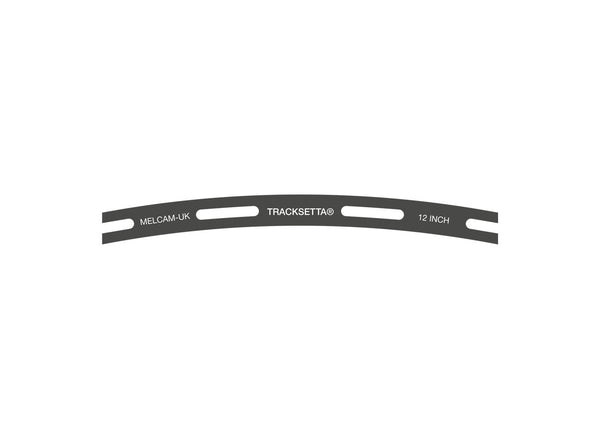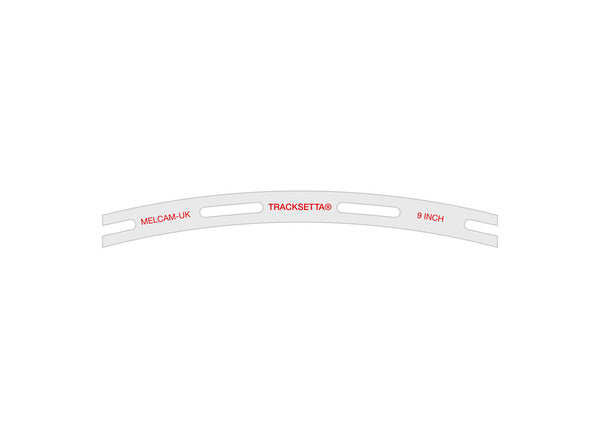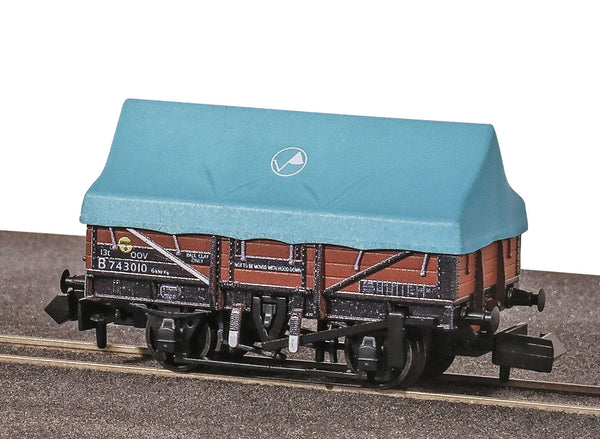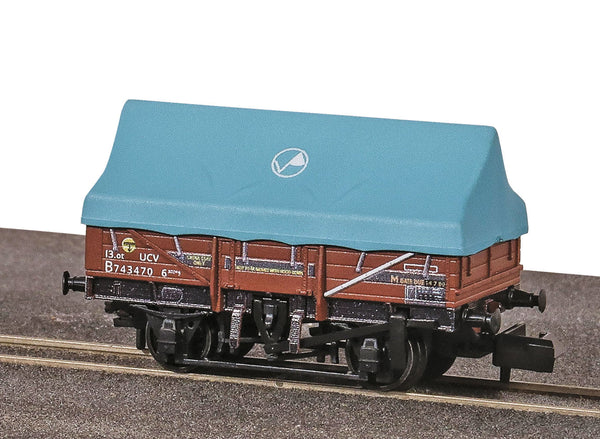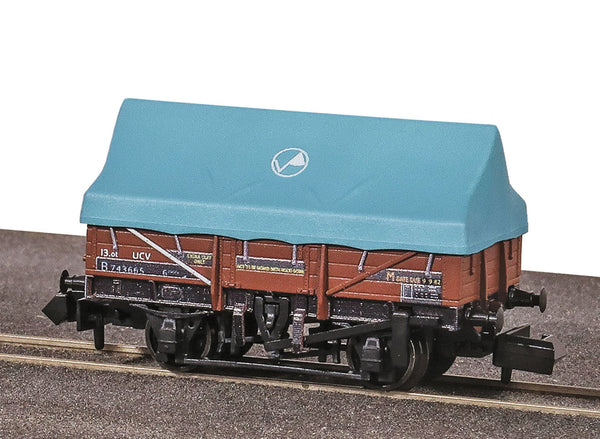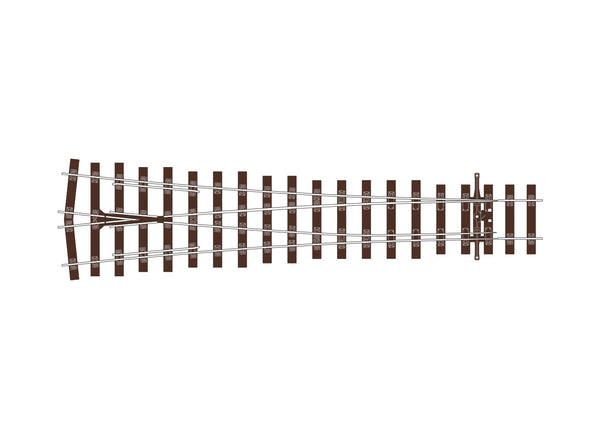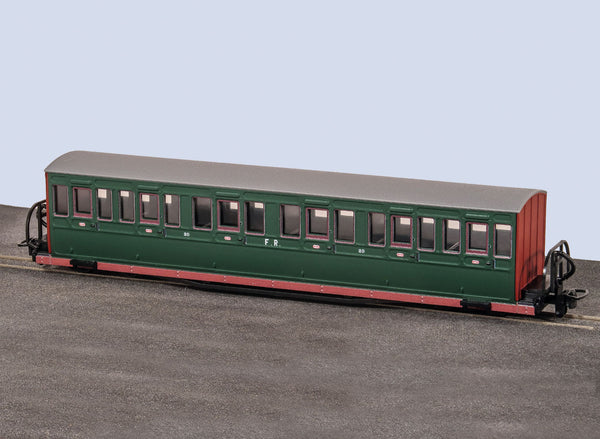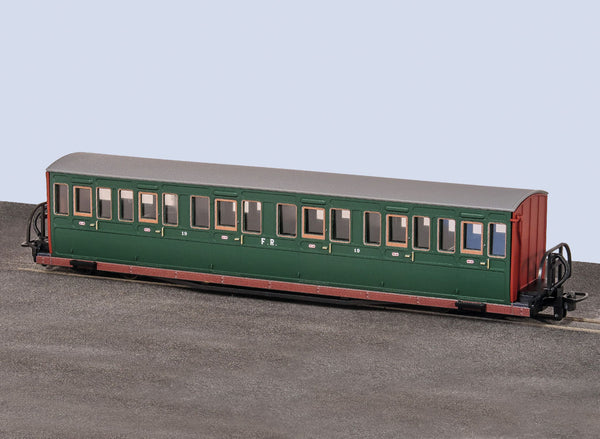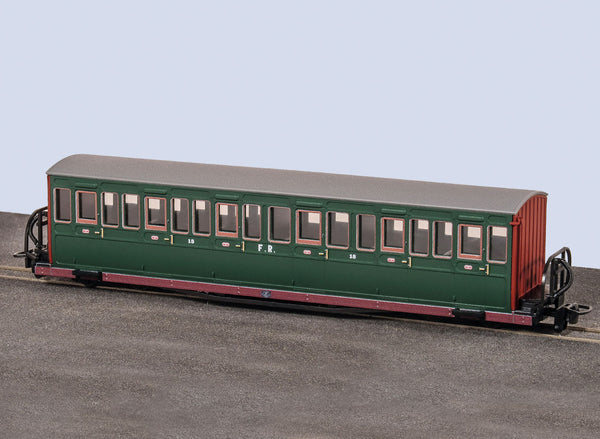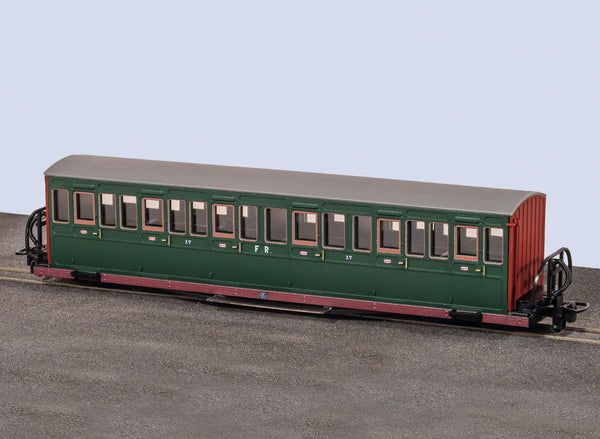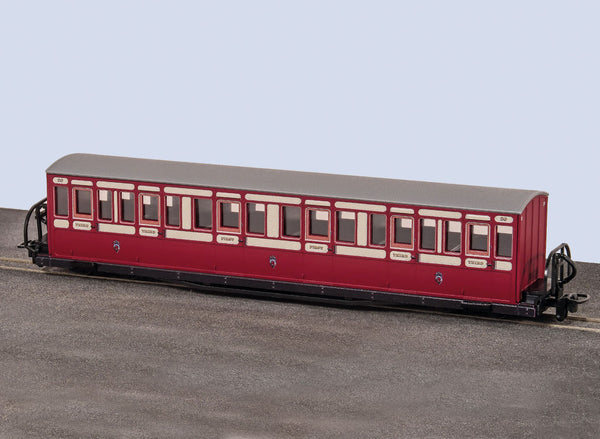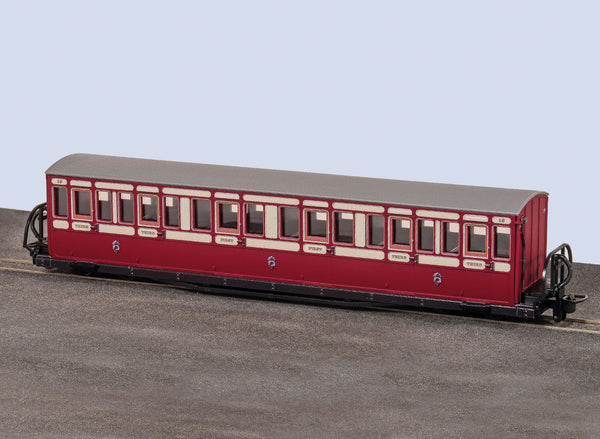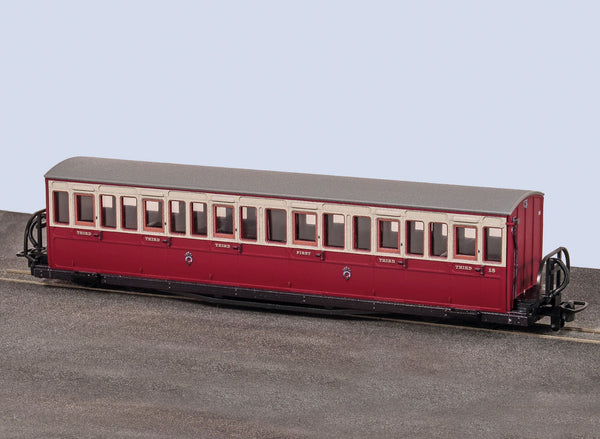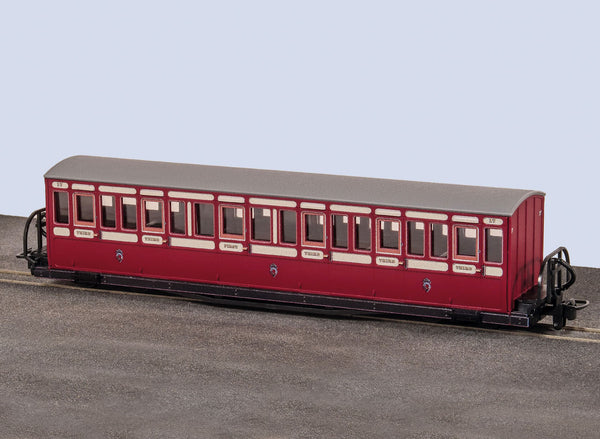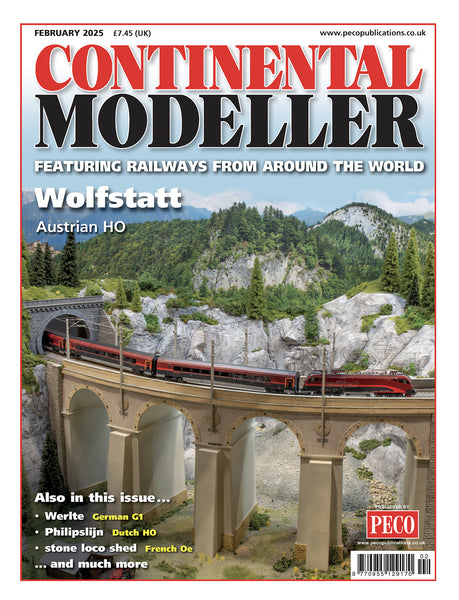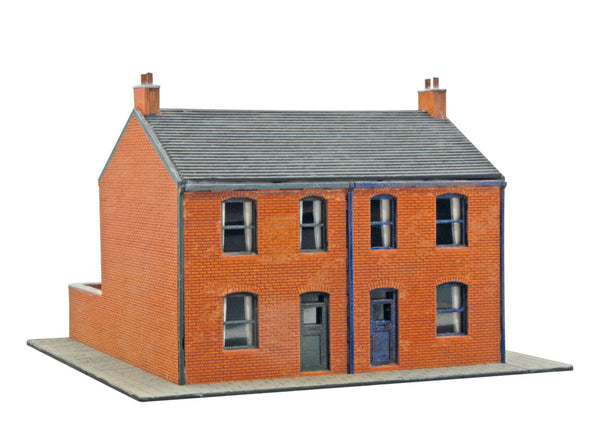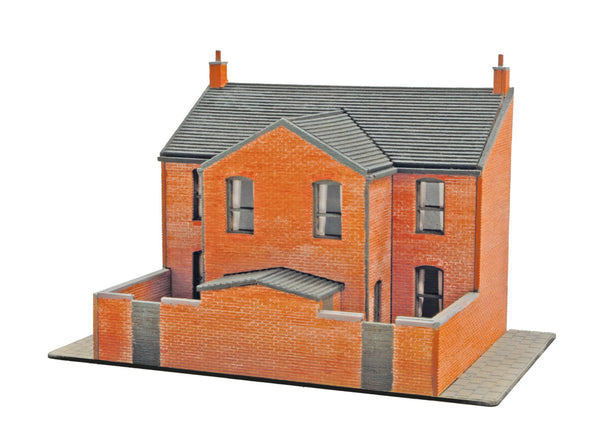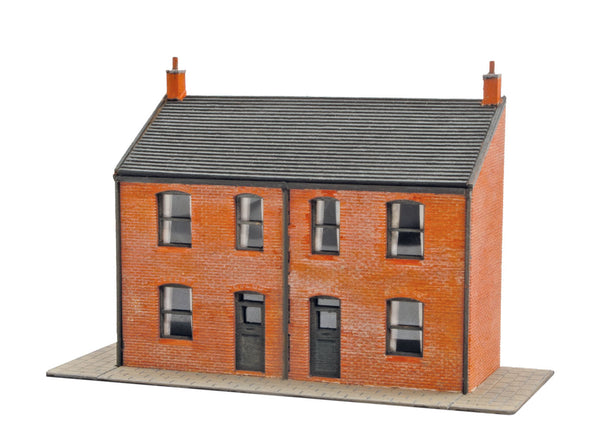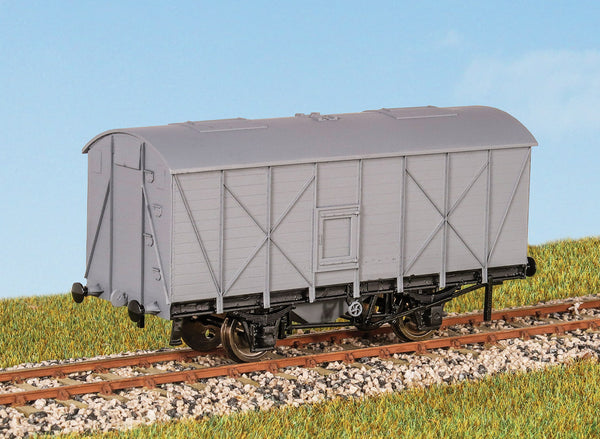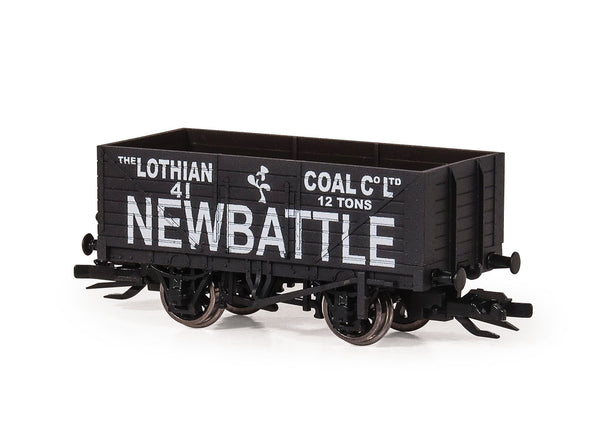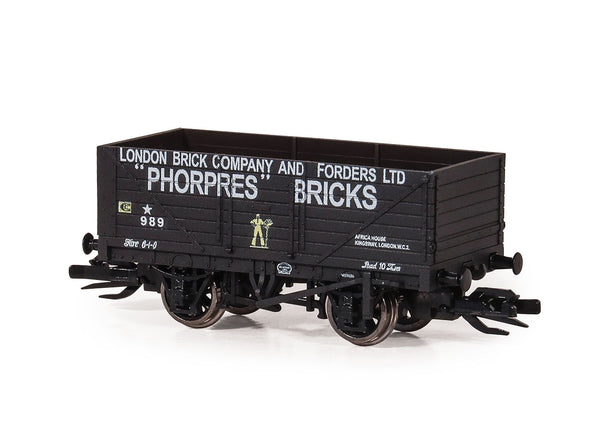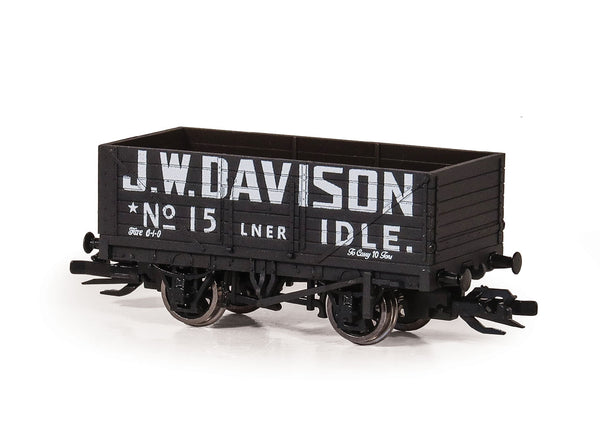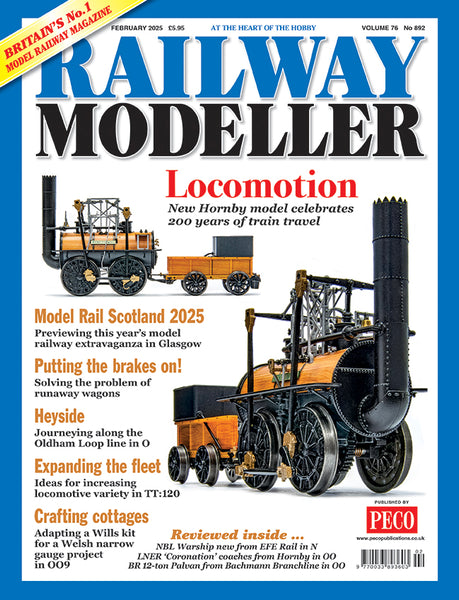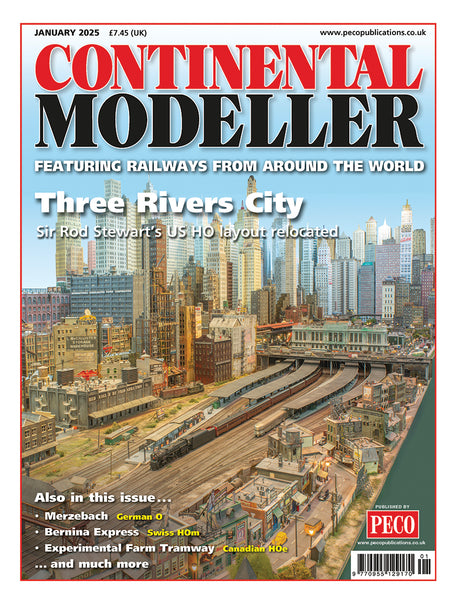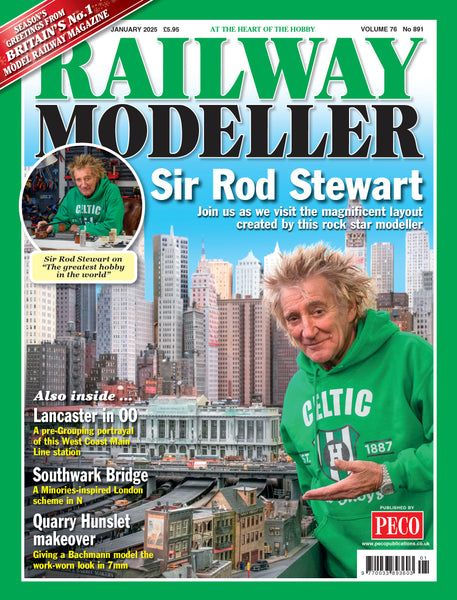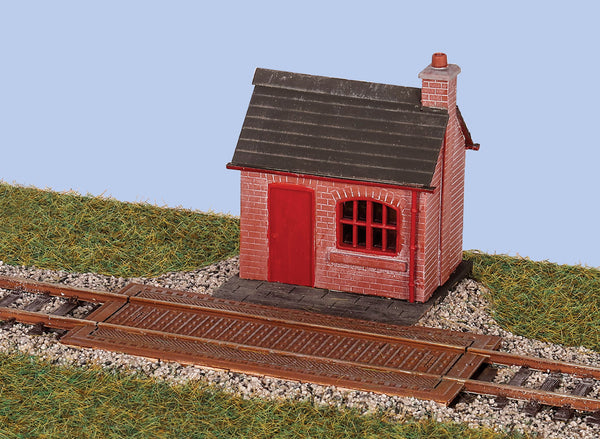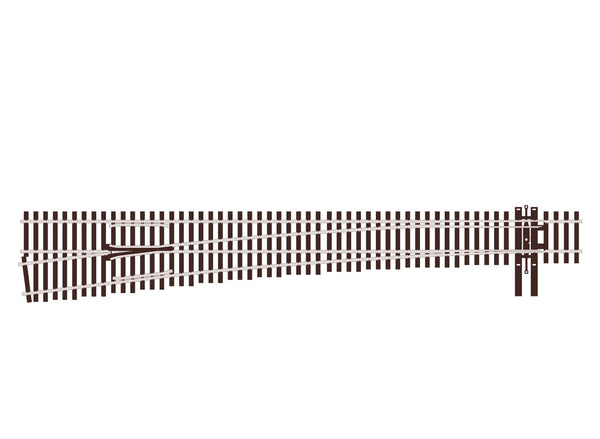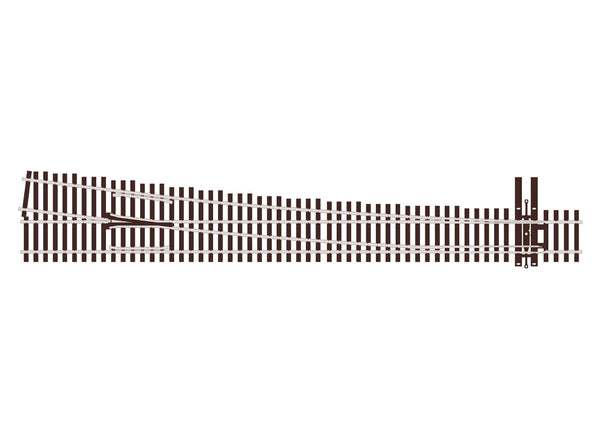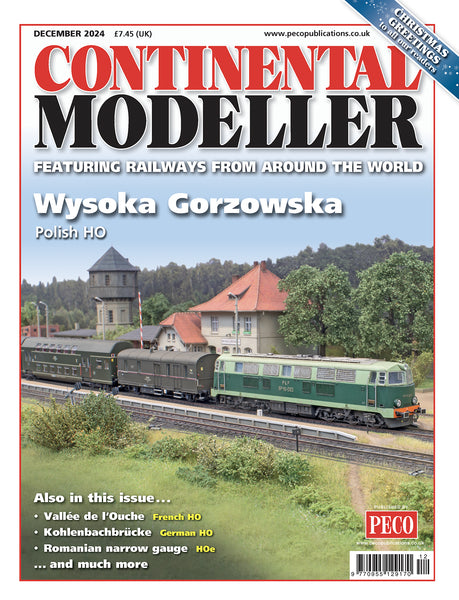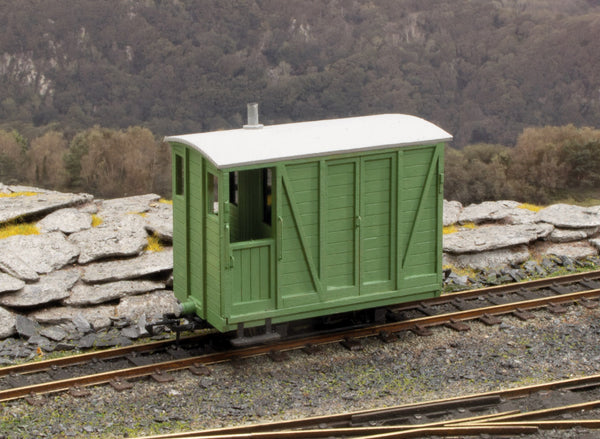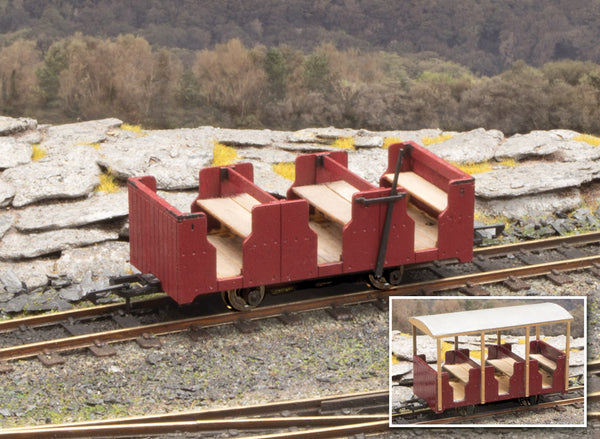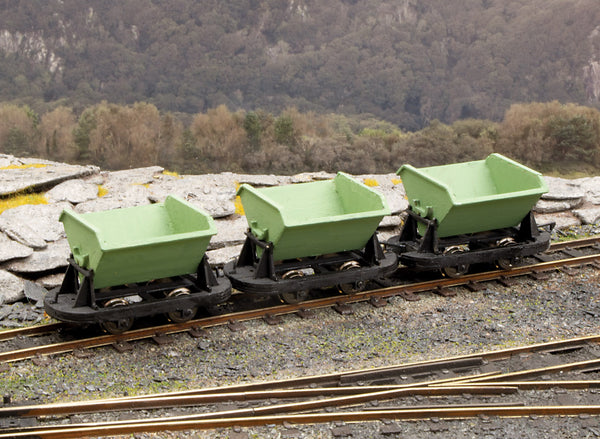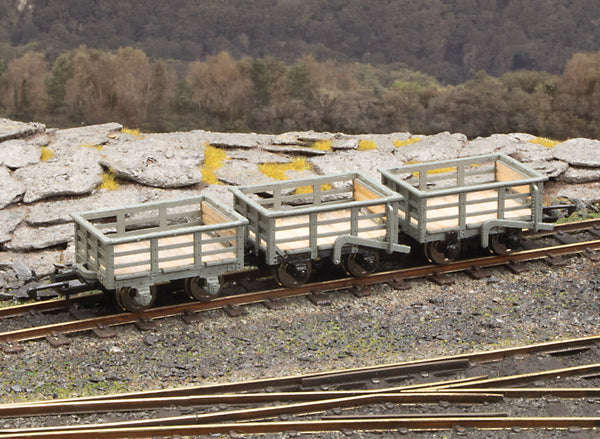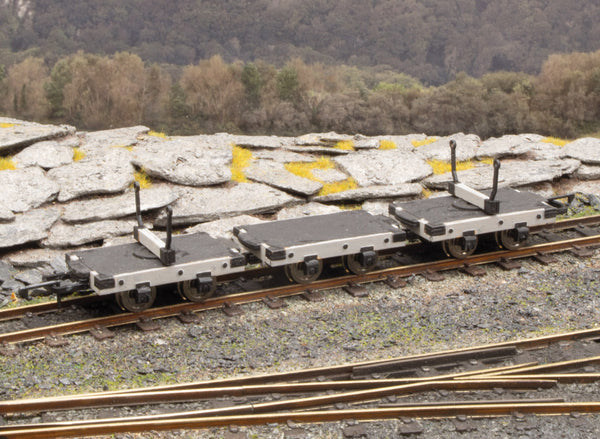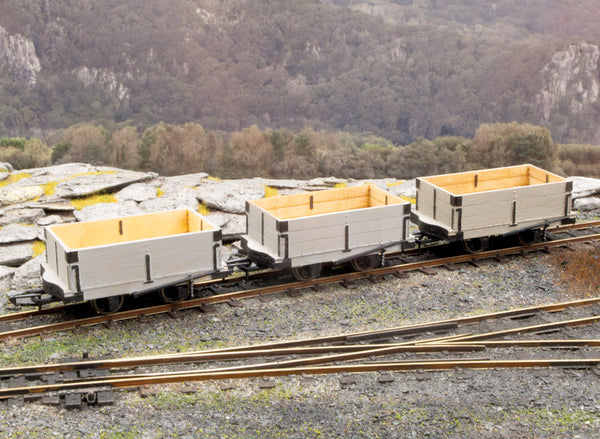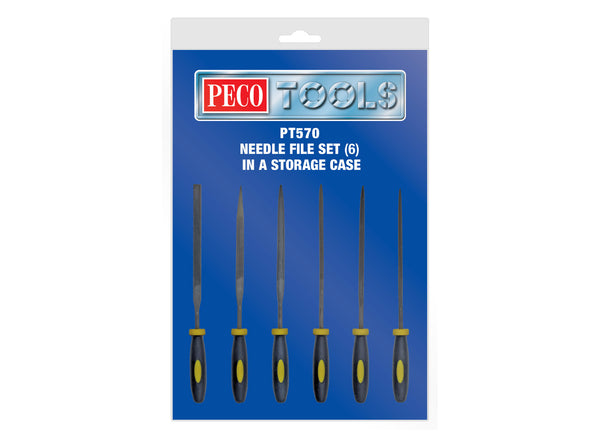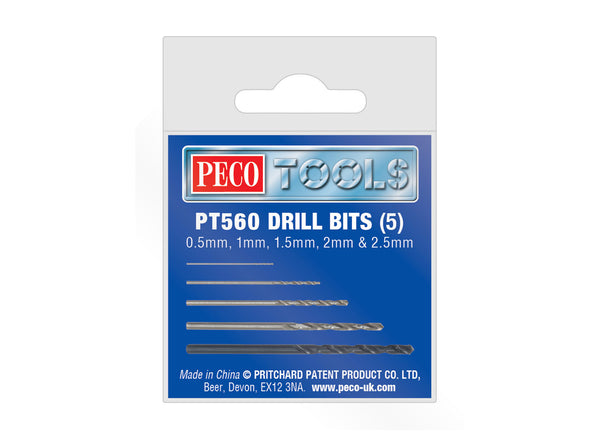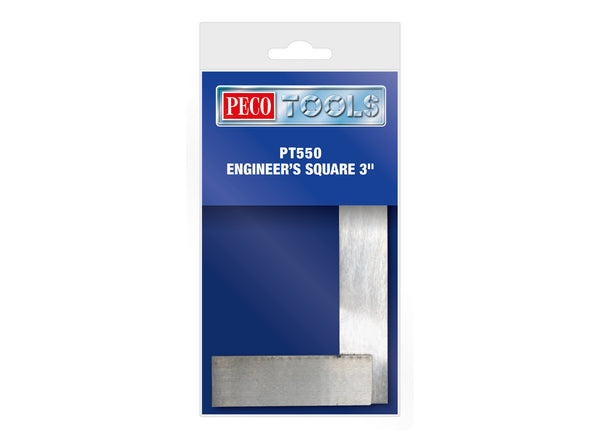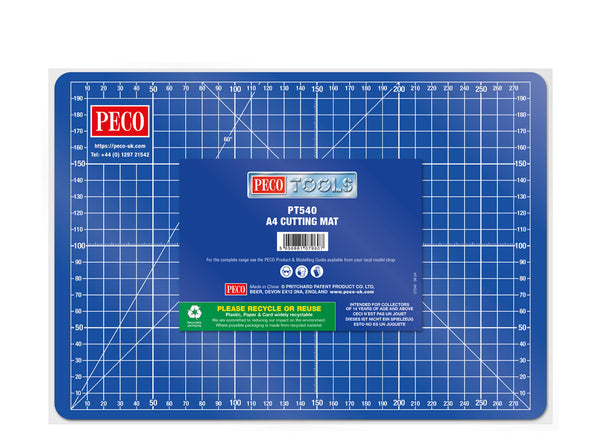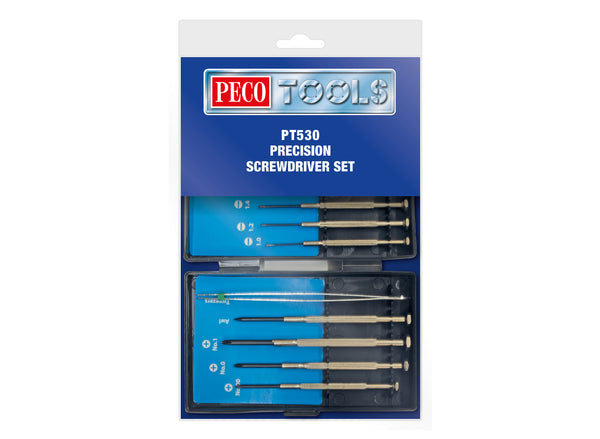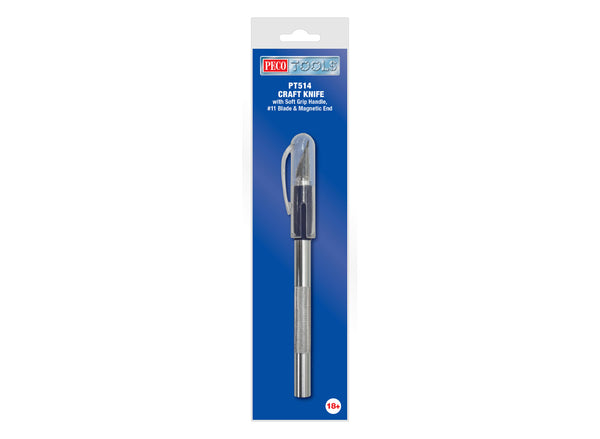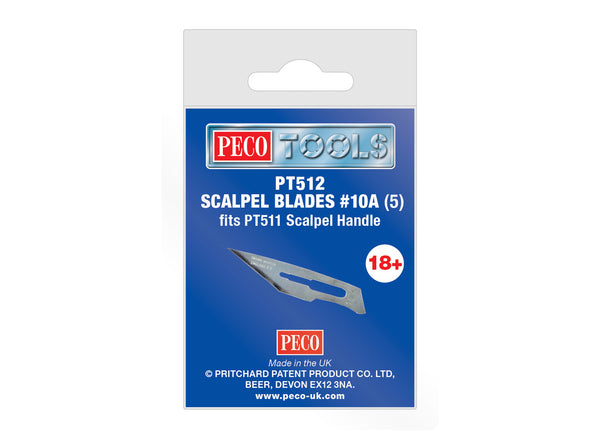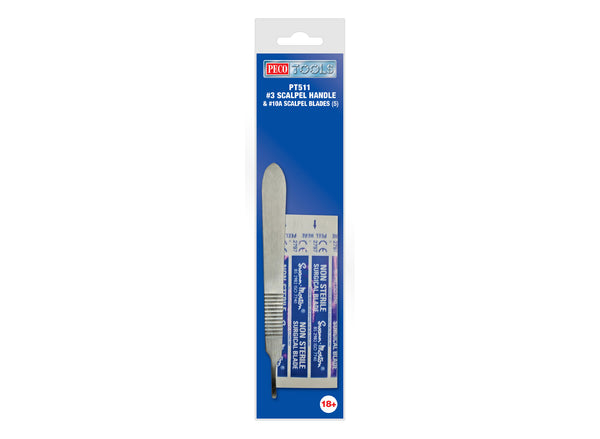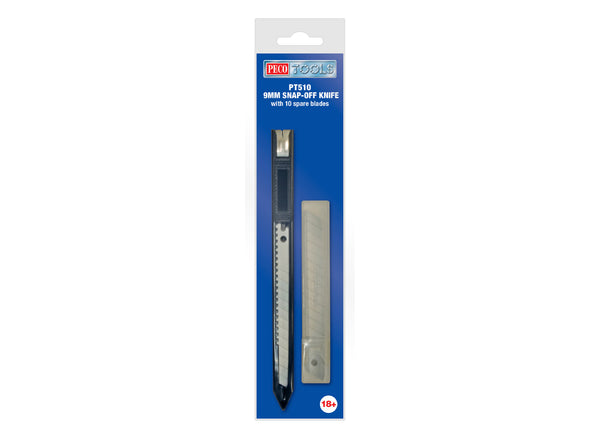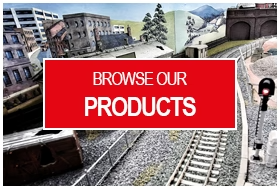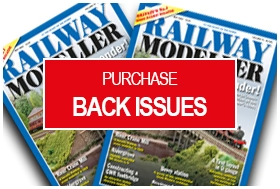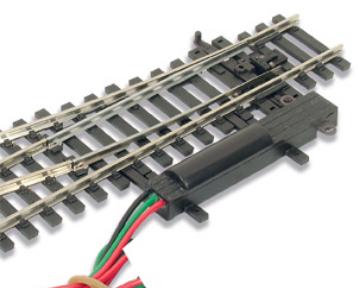BROWSE PECO PRODUCTS
Browse through our complete product portfolio.
2638 Products Found
TT:120 Tracksetta Template - 24" Radius
A new set of Tracksetta templates are now available. Essential tools for ensuring the best track laying possible with PECO Streamline flexible track, the addition of TT:120 templates now provides modellers in this 'new' scale the opportunity to ensure kink-free, realistic-looking track. Combining different radii also allow the laying of transition curves and reverse curves to best effect. As with the N/OO-9 and OO/HO scale Tracksetta templates these are made from powder-coated steel.
TT:120 Tracksetta Template - 21" Radius
A new set of Tracksetta templates are now available. Essential tools for ensuring the best track laying possible with PECO Streamline flexible track, the addition of TT:120 templates now provides modellers in this 'new' scale the opportunity to ensure kink-free, realistic-looking track. Combining different radii also allow the laying of transition curves and reverse curves to best effect. As with the N/OO-9 and OO/HO scale Tracksetta templates these are made from powder-coated steel.
TT:120 Tracksetta Template - 18" Radius
A new set of Tracksetta templates are now available. Essential tools for ensuring the best track laying possible with PECO Streamline flexible track, the addition of TT:120 templates now provides modellers in this 'new' scale the opportunity to ensure kink-free, realistic-looking track. Combining different radii also allow the laying of transition curves and reverse curves to best effect. As with the N/OO-9 and OO/HO scale Tracksetta templates these are made from powder-coated steel.
TT:120 Tracksetta Template - 15" Radius
A new set of Tracksetta templates are now available. Essential tools for ensuring the best track laying possible with PECO Streamline flexible track, the addition of TT:120 templates now provides modellers in this 'new' scale the opportunity to ensure kink-free, realistic-looking track. Combining different radii also allow the laying of transition curves and reverse curves to best effect. As with the N/OO-9 and OO/HO scale Tracksetta templates these are made from powder-coated steel.
TT:120 Tracksetta Template - 12" Radius
A new set of Tracksetta templates are now available. Essential tools for ensuring the best track laying possible with PECO Streamline flexible track, the addition of TT:120 templates now provides modellers in this 'new' scale the opportunity to ensure kink-free, realistic-looking track. Combining different radii also allow the laying of transition curves and reverse curves to best effect. As with the N/OO-9 and OO/HO scale Tracksetta templates these are made from powder-coated steel.
TT:120 Tracksetta Template - 9" Radius
A new set of Tracksetta templates are now available. Essential tools for ensuring the best track laying possible with PECO Streamline flexible track, the addition of TT:120 templates now provides modellers in this 'new' scale the opportunity to ensure kink-free, realistic-looking track. Combining different radii also allow the laying of transition curves and reverse curves to best effect. As with the N/OO-9 and OO/HO scale Tracksetta templates these are made from powder-coated steel.
NEW China Clay Hood Wagon, OOV B743010
Railway companies all had a stock of their own vehicles for carrying goods and merchandise around their network, and also onto other companies' routes as and when required. These were integrated into British Railways at Nationalisation; some of them to be once more re liveried under sectorisation as the network was prepared to be returned to private ownership. All PECO wagons feature free running wheels in pin point axles. The ELC coupling, whilst compatible with the standard N gauge couplings, keeps a realistic distance between the vehicles and enables the PL-25 electro magnetic decoupler to be used for remote uncoupling.
NEW China Clay Hood Wagon, UCV B743470, Bauxite
Railway companies all had a stock of their own vehicles for carrying goods and merchandise around their network, and also onto other companies' routes as and when required. These were integrated into British Railways at Nationalisation; some of them to be once more re liveried under sectorisation as the network was prepared to be returned to private ownership. All PECO wagons feature free running wheels in pin point axles. The ELC coupling, whilst compatible with the standard N gauge couplings, keeps a realistic distance between the vehicles and enables the PL-25 electro magnetic decoupler to be used for remote uncoupling.
NEW China Clay Hood Wagon, UCV B743665, Bauxite
Railway companies all had a stock of their own vehicles for carrying goods and merchandise around their network, and also onto other companies' routes as and when required. These were integrated into British Railways at Nationalisation; some of them to be once more re liveried under sectorisation as the network was prepared to be returned to private ownership. All PECO wagons feature free running wheels in pin point axles. The ELC coupling, whilst compatible with the standard N gauge couplings, keeps a realistic distance between the vehicles and enables the PL-25 electro magnetic decoupler to be used for remote uncoupling.
OO Bullhead Large Radius Y Turnout
The PECO Streamline OO Bullhead track range has shaped up to be a very comprehensive system comprising flexible track, bullhead joiners, buffer stop, large radius, medium radius turnout, a crossing, double & single slips and now Y turnouts. There's enough there already for modellers to build a truly authentic steam-to-diesel transition period layout.
- PECO Streamline OO Bullhead Large Radius Y Turnout, Unifrog
- Shares the same geometry as the existing Streamline Code 100, 75 flat bottom tracks systems
- Compatible with existing Bullhead system
- Uses standard SL-110 Code 75 rail joiner or the SL-114 Bullhead rail joiner
- Length 220mm, 8.7 inches
- Radius 1829mm, 72 inches
- Frog angle 12 degrees
- Unifrog
- High quality nickel silver rail for all rail parts, for optimal electrical conductivity
- One-piece machined point blade
- Over-centre spring to lock the point blade in place
- An excellent track component where space restrictions prevent standard turnouts being used, such as in a goods yard.
FR Long 'Bowsider' Coach - Colonel Stephens No.20
The Ffestiniog Railway operated two pairs of bogie coaches numbered 17-20 and built by Brown Marshalls & Co and Gloucester Wagon Co. They were known as ‘Bowsiders’ because of the tumblehome shape of their sides. Numbers 17 and 18, built in 1876 are shorter with one 1st class compartment. Numbers 19 and 20, built in 1879 are longer with two 1st class compartments. All four are still in service on the Ffestiniog Railway today.
In the 1920s the elaborate liveries of the Victorian era were replaced with a simple scheme of green with red end panels. It became known as the ‘Colonel Stephens’ livery, after the General Manager of the Ffestiniog Railway from 1925 until his passing in 1931. The colour scheme was used until the end of passenger operations in 1939, sometimes alongside other colours such as yellow, in the mid 1930s.
Green with red ends was applied to carriage No.20 once again from 2005 until 2024, as depicted by GR-623B.
FR Long 'Bowsider' Coach - Colonel Stephens No.19
The Ffestiniog Railway operated two pairs of bogie coaches numbered 17-20 and built by Brown Marshalls & Co and Gloucester Wagon Co. They were known as ‘Bowsiders’ because of the tumblehome shape of their sides. Numbers 17 and 18, built in 1876 are shorter with one 1st class compartment. Numbers 19 and 20, built in 1879 are longer with two 1st class compartments. All four are still in service on the Ffestiniog Railway today.
In the 1920s the elaborate liveries of the Victorian era were replaced with a simple scheme of green with red end panels. It became known as the ‘Colonel Stephens’ livery, after the General Manager of the Ffestiniog Railway from 1925 until his passing in 1931. The colour scheme was used until the end of passenger operations in 1939, sometimes alongside other colours such as yellow, in the mid 1930s.
Green with red ends was applied to carriage No.20 once again from 2005 until 2024, as depicted by GR-623B.
FR Short 'Bowsider' Coach - Colonel Stephens No.18
The Ffestiniog Railway operated two pairs of bogie coaches numbered 17-20 and built by Brown Marshalls & Co and Gloucester Wagon Co. They were known as ‘Bowsiders’ because of the tumblehome shape of their sides. Numbers 17 and 18, built in 1876 are shorter with one 1st class compartment. Numbers 19 and 20, built in 1879 are longer with two 1st class compartments. All four are still in service on the Ffestiniog Railway today.
In the 1920s the elaborate liveries of the Victorian era were replaced with a simple scheme of green with red end panels. It became known as the ‘Colonel Stephens’ livery, after the General Manager of the Ffestiniog Railway from 1925 until his passing in 1931. The colour scheme was used until the end of passenger operations in 1939, sometimes alongside other colours such as yellow, in the mid 1930s.
Green with red ends was applied to carriage No.20 once again from 2005 until 2024, as depicted by GR-623B.
FR Short 'Bowsider' Coach - Colonel Stephens No.17
The Ffestiniog Railway operated two pairs of bogie coaches numbered 17-20 and built by Brown Marshalls & Co and Gloucester Wagon Co. They were known as ‘Bowsiders’ because of the tumblehome shape of their sides. Numbers 17 and 18, built in 1876 are shorter with one 1st class compartment. Numbers 19 and 20, built in 1879 are longer with two 1st class compartments. All four are still in service on the Ffestiniog Railway today.
In the 1920s the elaborate liveries of the Victorian era were replaced with a simple scheme of green with red end panels. It became known as the ‘Colonel Stephens’ livery, after the General Manager of the Ffestiniog Railway from 1925 until his passing in 1931. The colour scheme was used until the end of passenger operations in 1939, sometimes alongside other colours such as yellow, in the mid 1930s.
Green with red ends was applied to carriage No.20 once again from 2005 until 2024, as depicted by GR-623B.
FR Long 'Bowsider' Coach - Red & Cream No.20
The Ffestiniog Railway operated two pairs of bogie coaches numbered 17-20 and built by Brown Marshalls & Co and Gloucester Wagon Co. They were known as ‘Bowsiders’ because of the tumblehome shape of their sides. Numbers 17 and 18, built in 1876 are shorter with one 1st class compartment. Numbers 19 and 20, built in 1879 are longer with two 1st class compartments. All four are still in service on the Ffestiniog Railway today.
The red and cream livery was first applied to a rake of carriages in 1987 for the ‘Mountain Prince’ train service. Carriage 20 was the first Bowsider to appear in the livery.
Carriages 17 and 18 had cream applied to the full upper half of the carriage. 17 had the mouldings reinstated in 1990 as depicted by GR-602A. 18 continued to have cream across the upper half throughout its time in the scheme, as represented by GR-602B. Note the ‘Brown Marshalls & Co. Ltd’ builders plate printed on the ends of the carriage.
All four Bowsiders were repainted into historic liveries in the 2000s, but the red and cream colour scheme is still seen today on the more modern carriages
FR Long 'Bowsider' Coach - Red & Cream No.19
The Ffestiniog Railway operated two pairs of bogie coaches numbered 17-20 and built by Brown Marshalls & Co and Gloucester Wagon Co. They were known as ‘Bowsiders’ because of the tumblehome shape of their sides. Numbers 17 and 18, built in 1876 are shorter with one 1st class compartment. Numbers 19 and 20, built in 1879 are longer with two 1st class compartments. All four are still in service on the Ffestiniog Railway today.
The red and cream livery was first applied to a rake of carriages in 1987 for the ‘Mountain Prince’ train service. Carriage 20 was the first Bowsider to appear in the livery.
Carriages 17 and 18 had cream applied to the full upper half of the carriage. 17 had the mouldings reinstated in 1990 as depicted by GR-602A. 18 continued to have cream across the upper half throughout its time in the scheme, as represented by GR-602B. Note the ‘Brown Marshalls & Co. Ltd’ builders plate printed on the ends of the carriage.
All four Bowsiders were repainted into historic liveries in the 2000s, but the red and cream colour scheme is still seen today on the more modern carriages
FR Short 'Bowsider' Coach - Red & Cream No.18
The Ffestiniog Railway operated two pairs of bogie coaches numbered 17-20 and built by Brown Marshalls & Co and Gloucester Wagon Co. They were known as ‘Bowsiders’ because of the tumblehome shape of their sides. Numbers 17 and 18, built in 1876 are shorter with one 1st class compartment. Numbers 19 and 20, built in 1879 are longer with two 1st class compartments. All four are still in service on the Ffestiniog Railway today.
The red and cream livery was first applied to a rake of carriages in 1987 for the ‘Mountain Prince’ train service. Carriage 20 was the first Bowsider to appear in the livery.
Carriages 17 and 18 had cream applied to the full upper half of the carriage. 17 had the mouldings reinstated in 1990 as depicted by GR-602A. 18 continued to have cream across the upper half throughout its time in the scheme, as represented by GR-602B. Note the ‘Brown Marshalls & Co. Ltd’ builders plate printed on the ends of the carriage.
All four Bowsiders were repainted into historic liveries in the 2000s, but the red and cream colour scheme is still seen today on the more modern carriages
FR Short 'Bowsider' Coach - Red & Cream No.17
The Ffestiniog Railway operated two pairs of bogie coaches numbered 17-20 and built by Brown Marshalls & Co and Gloucester Wagon Co. They were known as ‘Bowsiders’ because of the tumblehome shape of their sides. Numbers 17 and 18, built in 1876 are shorter with one 1st class compartment. Numbers 19 and 20, built in 1879 are longer with two 1st class compartments. All four are still in service on the Ffestiniog Railway today.
The red and cream livery was first applied to a rake of carriages in 1987 for the ‘Mountain Prince’ train service. Carriage 20 was the first Bowsider to appear in the livery.
Carriages 17 and 18 had cream applied to the full upper half of the carriage. 17 had the mouldings reinstated in 1990 as depicted by GR-602A. 18 continued to have cream across the upper half throughout its time in the scheme, as represented by GR-602B. Note the ‘Brown Marshalls & Co. Ltd’ builders plate printed on the ends of the carriage.
All four Bowsiders were repainted into historic liveries in the 2000s, but the red and cream colour scheme is still seen today on the more modern carriages
CONTINENTAL MODELLER February 2025 Vol.47 No.2
In this months issue...
RAILWAY OF THE MONTH - WOLFSTATT
Through a mountain landscape - Craig and Lewis Charity have built an impressive Austrian HO exhibition layout which has taken more than ten years.
NORDIC COAST
Something different - Jeff Mayhill has fashioned a novel 1 :220 display layout with an integral barrier.
PLAN OF THE MONTH - PETENNE
Roberto Macchi begins a series 4a on the design, construction, control, and operation of his Italian HO permanent layout.
+PLUS!
All the latest news, reviews and layouts from around the world!
Victorian House Complete, Lasercut Kit
The British Victorian red brick townhouse emerged during Queen Victoria's reign (1837–1901), reflecting the era's industrial and architectural advances. With the advent of mass brick production and rail transport, red bricks became affordable and widely available. Victorian architecture embraced Gothic Revival, Italianate, and Queen Anne styles, characterised by ornate detailing, bay windows, gables, and decorative brickwork. Red brick houses symbolised urban prosperity, particularly in growing industrial cities. Their durability and aesthetic appeal made them iconic in suburbs and working-class areas alike. Today, these houses endure as a hallmark of Victorian design, blending function with the artistic aspirations of the era.
Victorian House Backs, Lasercut Kit
The British Victorian red brick townhouse emerged during Queen Victoria's reign (1837–1901), reflecting the era's industrial and architectural advances. With the advent of mass brick production and rail transport, red bricks became affordable and widely available. Victorian architecture embraced Gothic Revival, Italianate, and Queen Anne styles, characterised by ornate detailing, bay windows, gables, and decorative brickwork. Red brick houses symbolised urban prosperity, particularly in growing industrial cities. Their durability and aesthetic appeal made them iconic in suburbs and working-class areas alike. Today, these houses endure as a hallmark of Victorian design, blending function with the artistic aspirations of the era.
Victorian House Fronts, Lasercut Kit
The British Victorian red brick townhouse emerged during Queen Victoria's reign (1837–1901), reflecting the era's industrial and architectural advances. With the advent of mass brick production and rail transport, red bricks became affordable and widely available. Victorian architecture embraced Gothic Revival, Italianate, and Queen Anne styles, characterised by ornate detailing, bay windows, gables, and decorative brickwork. Red brick houses symbolised urban prosperity, particularly in growing industrial cities. Their durability and aesthetic appeal made them iconic in suburbs and working-class areas alike. Today, these houses endure as a hallmark of Victorian design, blending function with the artistic aspirations of the era.
British Railways Bulk Grain Wagon Kit (LNER)
Around 100 of these vans were built by the LNER between 1921 and 1936 for the transportation of grain, initially from the Port of Hull. In time their use became more widespread, often finding work transporting barley from Lincolnshire to the maltings in Scotland. The remaining wagons were retired in the mid-1970s.
Our new kit really is all-new. Brand new tooling producing some very fine plastic mouldings. In addition to that the kit includes brass bearings, fine scale metal wheels and NEM pockets for the tension lock couplers included. A set of waterslide decals for both the LNER and BR periods are included. Assembly is really straight forward aided by the clear and helpful instructions. The resulting model is one that would make a fine addition to any layout, and from a retailer's point of view there is the added attraction of being able to sell multiple kits given that modellers would likely require a rake of these wagons!
TT:120 7-Plank Open Wagon, Newbattle
- Fine plastic moulding with thinner wagon body walls for accuracy.
- Interior detail as well as a high-level of exterior detail
- Separately-fitted brake lever.
- Brake shoes in line with the wheels
- Ultra-fine printing detail
- Free-running metal-tyred wheels
- Standard (removable) TT:120 coupler compatible with other TT:120 rolling stock on the market
TT:120 7-Plank Open Wagon, Phorpres Bricks
- Fine plastic moulding with thinner wagon body walls for accuracy.
- Interior detail as well as a high-level of exterior detail
- Separately-fitted brake lever.
- Brake shoes in line with the wheels
- Ultra-fine printing detail
- Free-running metal-tyred wheels
- Standard (removable) TT:120 coupler compatible with other TT:120 rolling stock on the market
TT:120 7-Plank Open Wagon, J. W. Davison
- Fine plastic moulding with thinner wagon body walls for accuracy.
- Interior detail as well as a high-level of exterior detail
- Separately-fitted brake lever.
- Brake shoes in line with the wheels
- Ultra-fine printing detail
- Free-running metal-tyred wheels
- Standard (removable) TT:120 coupler compatible with other TT:120 rolling stock on the market
RAILWAY MODELLER February 2025 Vol.76 No.892
RAILWAY OF THE MONTH
Helston Reimagined
Richard Lambert describes the background to this imagined main line station, which is set on the Oldham Loop line between Manchester Victoria and Rochdale, in former Lancashire & Yorkshire Railway territory.
PLAN OF THE MONTH
Southwark Bridge
Dave Howsam planned a new version of his first layout - a fictional Great Western Railway branch line in 00, named Porth/even - which ended up resembling, somewhat more closely, the real station in Cornwall that originally inspired it.
PLUS ALL THE LATEST NEWS & REVIEWS...
CONTINENTAL MODELLER January 2025 Vol.47 No.1
In this months issue...
RAILWAY OF THE MONTH - GRAND STREET & THREE RIVERS CITY
Sir Rod Stewart has had his extensive American HO layout transferred from California to Britain, where it has been rebuilt and further expanded, with more to come.
WEATHERING WAGONS
Peter Marriott shows how he makes modern HO stock look that bit more realistic.
PLAN OF THE MONTH - KLEIN SCHMALITZ
Antony Dean designed a portable German HO layout with a twist – it can be presented in four time periods.
+PLUS!
All the latest news, reviews and layouts from around the world!
RAILWAY MODELLER January 2025 Vol.76 No.891
RAILWAY OF THE MONTH
Lancaster
Jon Chamberlain describes how he set about building this pre-Grouping 00 gauge depiction of a classic West Coast Main Line station in his garage.
PLAN OF THE MONTH
Southwark Bridge
For his fictional London terminus station, Graham Bridge turned to a classic Cyril J Freezer track plan - Minories, first published in RAILWAY MODELLER in April 1957.
PLUS ALL THE LATEST NEWS & REVIEWS...
Goods Yard Weighbridge
One of the fundamental aspects of safety on the railway was that wagons should never be overloaded. To do so would risk trains not having sufficient braking capacity to slow and stop safely. To manage loading at many industrial locations, each wagon would pass over a Weighbridge - to check their weight. Each wagon would display its tare weight, which could be deducted from the total weight, to ascertain the net weight of the load - simple mathematics! The new Ratio kit is a great representation of a typical Weighbridge, not dissimilar to the one, once located at Shildon Wagon Works in the North East. Combining a mixture of materials, the plastic parts make up the hut and laser-cut wood parts form the actual weighing scales, which fit in and around a length of ST-201 PECO Setrack track, included in the kit.
Another useful addition to the extensive range of Ratio OO/HO scale railway structure kits.
Code 70, No.8, Left Hand Turnout, Unifrog
Whilst our HO Code 83 track is perfect for modelling American mainlines, this new Code 70 track is just right for secondary lines, lightly-used branches, sidings, etc. Indeed, it will be perfect for modelling the early-to-mid 20th century railroading era when lighter rail was more commonly used. Featuring accurate rail spike detail, correctly proportioned ties (sleepers) and nickel silver rail, this new flexible track has been produced to the same high standard that modellers have come to expect from PECO and confirms to the specifications laid down by the NMRA..
Code 70, No.8, Right Hand Turnout, Unifrog
Whilst our HO Code 83 track is perfect for modelling American mainlines, this new Code 70 track is just right for secondary lines, lightly-used branches, sidings, etc. Indeed, it will be perfect for modelling the early-to-mid 20th century railroading era when lighter rail was more commonly used. Featuring accurate rail spike detail, correctly proportioned ties (sleepers) and nickel silver rail, this new flexible track has been produced to the same high standard that modellers have come to expect from PECO and confirms to the specifications laid down by the NMRA..
CONTINENTAL MODELLER December 2024 Vol.46 No.12
In this months issue...
RAILWAY OF THE MONTH - WYSOKA GORZOWSKA
Tomasz Florczak describes a rural passing station in western Poland which he has modelled in HO as a tribute to his grandfather, the former stationmaster.
WEATHERING WAGONS
Peter Marriott shows how he makes modern HO stock look that bit more realistic.
PLAN OF THE MONTH - CHIRM
Stephen Foster has constructed an American HO layout in his garage, set on the rarely modelled Monon Railroad.
+PLUS!
All the latest news, reviews and layouts from around the world!
GVT Brakevan Laser-cut kit (NG7)
Laser cut wagon kit of a 4-wheel Glyn Valley Tramway brakevan.
Penrhyn Quarry Workmen's Coach Laser-cut kit (NG7)
Laser cut wagon kit of a 4-wheel narrow Penrhyn Quarry Workmen's Coach, easily adapted for anyone's freelance railway.
V-Skip Side Tip Wagons (3) Laser-cut kits (NG7)
Laser cut wagon kit of a 4-wheel narrow gauge V-Skip wagons found at many industrial locations.
Tipper body can be left loose to enable it to tip prototypically.
Features metal disk wheels that run freely in brass bearings.
Contains plastic tension-lock couplings and NEM pockets. Options for omitting couplings completely or fitting them integrally to the wagon chassis for prototypical close-coupling.
Pack of 3 wagons.
Penrhyn Quarry Railway Slate Wagons (3) Laser-cut kits (NG7)
Laser-cut wagon kits of 4-wheel narrow gauge bolster wagons found at many industrial locations.
Penrhyn Quarry Railway Bolster Wagons (3) Laser-cut kits (NG7)
Laser-cut wagon kits of 4-wheel narrow gauge bolster wagons found at many industrial locations.
GVT Open Wagons (3) Laser-cut kits (NG7)
Laser-cut wagon kit of 3 x 4-wheel narrow gauge open wagons found at many industrial locations.
Needle File Set (box 6)
A specially selected tool from expert modellers here at PECO for kit building. Smooth off sharp edges on plastic kit and cut rail ends.
Box of 5 drill bits 0.5 to 2.5mm
A specially selected tool from expert modellers here at PECO for kit building. Use with the PECO Tools Pin Vice PT-508
Engineer's Square 3"
A specially selected tool from expert modellers here at PECO for kit building. For achieving perfect right angles when constructing building kits.
A4 Cutting Mat
A specially selected tool from expert modellers here at PECO for kit building. Protect the table with this essential 'self-healing' modelling mat.
Precision Screwdriver Set
A specially selected tool from expert modellers here at PECO for kit building. An essential set of screwdrivers for many modelling applications, including locomotive maintenance.
Soft-grip Craft Knife & blades
A specially selected tool from expert modellers here at PECO for kit building. A comfortable knife for handling a multitude of cutting jobs in the hobby room.
Soft-grip Craft Knife No.11 Blades
A specially selected tool from expert modellers here at PECO for kit building. A scalpel handle with disposable scalpel blades. For cutting plastic components.
Scalpel Handle No. 3 & 10A Scalpel Blades (5)
A specially selected tool from expert modellers here at PECO for kit building. A scalpel handle with disposable scalpel blades. For cutting plastic components.
Snap-off Knife & Blades (9mm)
A specially selected tool from expert modellers here at PECO for kit building. A general-purpose modelling knife with 10 x snap-off blade tips for when they go blunt.
